May 2003 lunar eclipse
A total lunar eclipse took place on May 16, 2003, the first of two total lunar eclipses in 2003, the other being on November 9, 2003.
| Total eclipse | |||||||||||||||||
 From Minneapolis, Minnesota, 3:17 UTC | |||||||||||||||||
| Date | 16 May 2003 | ||||||||||||||||
|---|---|---|---|---|---|---|---|---|---|---|---|---|---|---|---|---|---|
| Gamma | 0.41234 | ||||||||||||||||
| Magnitude | 1.12759 | ||||||||||||||||
| Saros cycle | 121 (54 of 82) | ||||||||||||||||
| Totality | 51 minutes, 25 seconds | ||||||||||||||||
| Partiality | 193 minutes, 55 seconds | ||||||||||||||||
| Penumbral | 306 minutes, 37 seconds | ||||||||||||||||
| |||||||||||||||||
This lunar eclipse is first of a tetrad, four total lunar eclipses in series. The previous series was in 1985 and 1986, starting with a May 1985 lunar eclipse. The next one was in 2014 and 2015, starting with the April 15, 2014 lunar eclipse.
Visibility

Gallery
 From Minneapolis, Minnesota, 3:35 UTC, wide angle, near greatest eclipse
From Minneapolis, Minnesota, 3:35 UTC, wide angle, near greatest eclipse
Relation to other lunar eclipses
Eclipses of 2003
Lunar year series
It is also the second of four lunar year cycles, repeating every 354 days.
| Lunar eclipse series sets from 2002–2005 | ||||||||
|---|---|---|---|---|---|---|---|---|
| Descending node | Ascending node | |||||||
| Saros Photo |
Date View |
Type Chart |
Gamma | Saros Photo |
Date View |
Type Chart |
Gamma | |
| 111 | 2002 May 26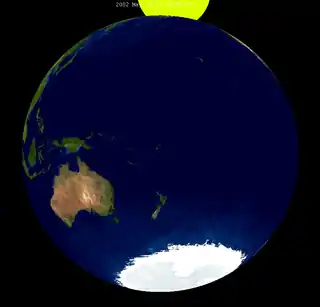 |
penumbral |
1.1759 | 116 | 2002 Nov 20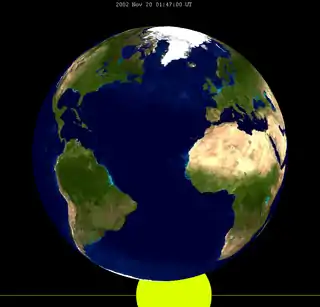 |
penumbral |
-1.1127 | |
121 |
2003 May 16 |
total |
0.4123 | 126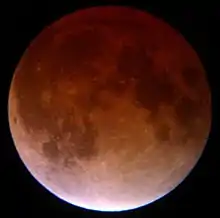 |
2003 Nov 09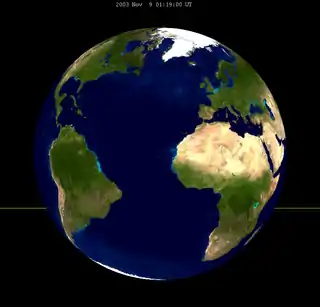 |
total |
-0.4319 | |
131 |
2004 May 04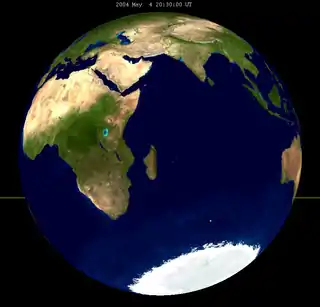 |
total |
-0.3132 | 136 |
2004 Oct 28 |
total |
0.2846 | |
| 141 | 2005 Apr 24 |
penumbral |
-1.0885 | 146_(cropped).jpg.webp) |
2005 Oct 17 |
partial |
0.9796 | |
| Last set | 2002 Jun 24 | Last set | 2001 Dec 30 | |||||
| Next set | 2006 Mar 14 | Next set | 2006 Sep 7 | |||||
Metonic series
This eclipse is the second of four Metonic cycle lunar eclipses on the same date, May 15–16, each separated by 19 years.
The Metonic cycle repeats nearly exactly every 19 years and represents a Saros cycle plus one lunar year. Because it occurs on the same calendar date, the earth's shadow will be in nearly the same location relative to the background stars.
|
|
 |
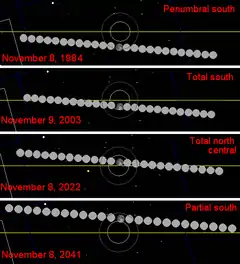 |
Half-Saros cycle
A lunar eclipse will be preceded and followed by solar eclipses by 9 years and 5.5 days (a half saros).[1] This lunar eclipse is related to two annular solar eclipses of Solar Saros 128.
| May 10, 1994 | May 20, 2012 |
|---|---|
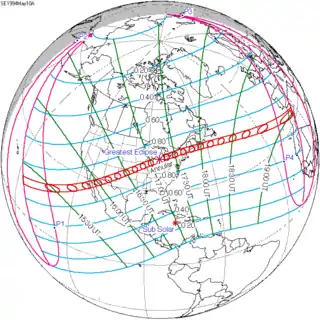 |
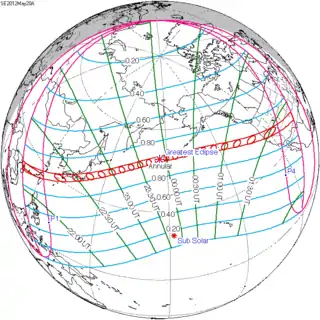 |
See also
- List of lunar eclipses and List of 21st-century lunar eclipses
- November 2003 lunar eclipse
- October 2004 lunar eclipse
- May 2004 lunar eclipse
References
- Mathematical Astronomy Morsels, Jean Meeus, p.110, Chapter 18, The half-saros
External links
- Saros cycle 121
- 2003 May 16 chart: Eclipse Predictions by Fred Espenak, NASA/GSFC
- NASA Saros series 121
- Lunar Eclipse Gallery
- Pictures of the May 15-16 Lunar Eclipse
- Prof. Druckmüller's eclipse photography site. Czech Republic
| Wikimedia Commons has media related to Lunar eclipse of 2003 May 16. |

